The automotive three way catalytic converter market is estimated to be valued at USD 11.9 billion in 2025 and is projected to reach USD 21.7 billion by 2035, registering a compound annual growth rate (CAGR) of 6.2% over the forecast period.
The automotive three way catalytic converter market is projected to grow from USD 11.9 billion in 2025 to USD 21.7 billion by 2035, reflecting a CAGR of 6.2%. This growth is expected to be driven by increasing regulatory compliance requirements for emission control, alongside a rise in vehicle production and replacement demand across both developed and emerging regions. Market expansion is anticipated as manufacturers focus on enhancing catalyst efficiency, reducing material costs, and integrating advanced emission control solutions into passenger and commercial vehicles. Year-on-year revenue gains are likely to be influenced by production volumes, material availability, and regional policy enforcement.
During the 2025–2035 period, the automotive three way catalytic converter market is expected to experience steady annual growth, underpinned by rising automotive sales and replacement cycles in mature markets. Competitive dynamics, including strategic partnerships, supplier consolidation, and regional manufacturing expansions, are likely to shape market share distribution and pricing trends. Overall, the market trajectory suggests sustained value accumulation, as emission standards enforcement and increasing adoption of emission reduction technologies drive demand for three way catalytic converters across diverse automotive segments.
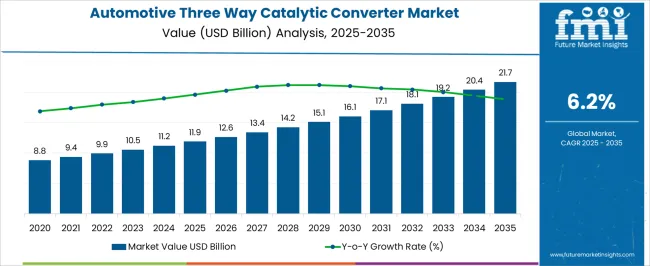
| Metric | Value |
|---|---|
| Automotive Three Way Catalytic Converter Market Estimated Value in (2025 E) | USD 11.9 billion |
| Automotive Three Way Catalytic Converter Market Forecast Value in (2035 F) | USD 21.7 billion |
| Forecast CAGR (2025 to 2035) | 6.2% |
The automotive three way catalytic converter market is estimated to hold a notable proportion within its parent markets, representing approximately 15-18% of the automotive exhaust systems market, around 20-22% of the emission control systems market, close to 10-12% of the automotive aftermarket parts market, about 8-10% of the vehicle emission reduction market, and roughly 5-6% of the automotive components market. Collectively, the cumulative share across these parent segments is observed in the range of 58-68%, reflecting the significant role that three way catalytic converters play in controlling harmful emissions and supporting compliance with environmental regulations across global automotive sectors.
The market has been driven by the increasing regulatory focus on reducing nitrogen oxides, carbon monoxide, and hydrocarbons in passenger and commercial vehicles, along with consumer demand for vehicles that deliver efficient performance while minimizing environmental impact. Adoption is influenced by OEM integration strategies, durability requirements, and the compatibility of converters with diverse engine types and fuel systems. Market participants have focused on developing advanced catalysts, optimizing converter design, and improving thermal efficiency to enhance overall vehicle performance. As a result, the automotive three way catalytic converter market has captured a meaningful share within exhaust systems, emission control, and aftermarket sectors, emphasizing its role in emission management, regulatory compliance, and the long-term efficiency of internal combustion engines.
The automotive three way catalytic converter market is expanding steadily due to stringent global emission norms and rising awareness of environmental sustainability. Regulatory mandates across major economies have enforced tighter controls on NOx, CO, and hydrocarbon emissions, compelling automakers to adopt efficient catalytic technologies.
As internal combustion engine (ICE) vehicles continue to dominate global roads, particularly in emerging economies, demand for catalytic converters remains resilient. Innovation in material efficiency, durability, and heat resistance is reinforcing market competitiveness and long-term application potential.
Looking ahead, despite the gradual shift toward electrification, the ongoing production of hybrid and gasoline-powered vehicles is expected to ensure continued relevance of three way catalytic converters. As OEMs focus on cost-effective compliance with evolving emission standards, the market is poised for stable performance driven by regulatory alignment and vehicle production trends
The automotive three way catalytic converter market is segmented by material, vehicle, propulsion, distribution channel, and geographic regions. By material, automotive three way catalytic converter market is divided into platinum-based, palladium-based, and rhodium-based. In terms of vehicle, automotive three way catalytic converter market is classified into passenger vehicles and commercial vehicles. Based on propulsion, automotive three way catalytic converter market is segmented into gasoline, diesel, and others. By distribution channel, automotive three way catalytic converter market is segmented into OEM and aftermarket. Regionally, the automotive three way catalytic converter industry is classified into North America, Latin America, Western Europe, Eastern Europe, Balkan & Baltic Countries, Russia & Belarus, Central Asia, East Asia, South Asia & Pacific, and the Middle East & Africa.
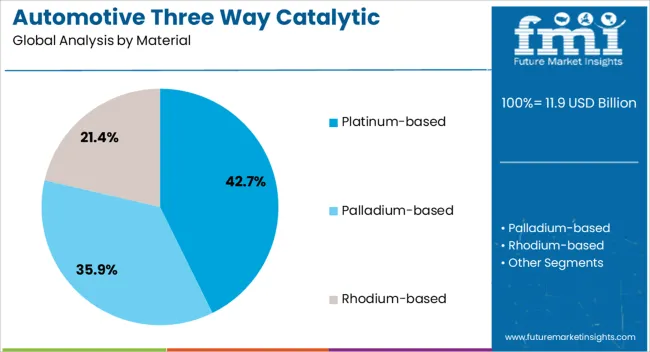
The platinum-based segment leads the material category with a 42.7% share, reflecting its high catalytic activity and thermal stability under extreme exhaust conditions. Platinum’s superior oxidation and reduction properties enable efficient conversion of harmful pollutants, making it indispensable in emission control systems.
Although its high cost has prompted partial substitution with palladium and rhodium in some regions, platinum remains a core material due to its resilience in diverse operating environments. The segment has seen steady demand from both OEMs and aftermarket players seeking reliability and performance in emission-sensitive regions.
Advancements in catalyst design and recycling technologies have further optimized platinum usage without compromising efficiency. As emission norms grow stricter and engine architectures become more complex, platinum-based converters are expected to retain a significant role in enabling cleaner combustion across a wide range of vehicle platforms
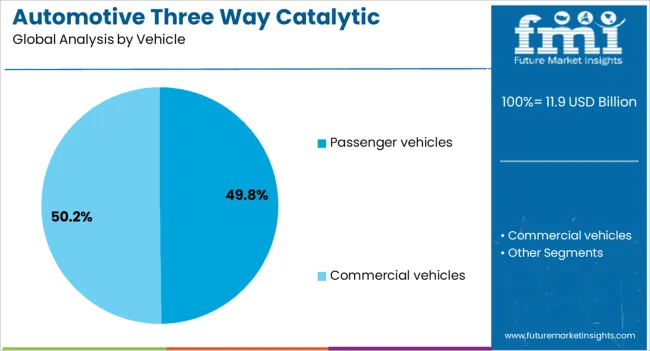
The commercial vehicles segment constitutes 50.2% of the market share in the vehicle category, driven by the expansion of freight transport, logistics, and public mobility services worldwide. These vehicles represent a substantial installed base for catalytic converters due to their larger engine capacities, higher emission outputs, and intensive duty cycles.
Governments in both developed and emerging economies continue to tighten emission regulations for heavy-duty fleets, including standards equivalent to Euro VI and EPA norms, compelling manufacturers to adopt advanced catalytic after-treatment technologies. The segment has further benefited from the growth of e-commerce, rising infrastructure investments, and increasing demand for long-haul transportation, all of which sustain high utilization rates for commercial vehicles.
Additionally, bus and truck manufacturers are incorporating durable, high-capacity catalytic converters designed to withstand extended operational hours and variable fuel quality, reinforcing consistent segment revenue. The outlook remains strong as regulatory frameworks evolve and demand for efficient, low-emission commercial fleets rises, particularly in Asia-Pacific, North America, and rapidly industrializing regions.
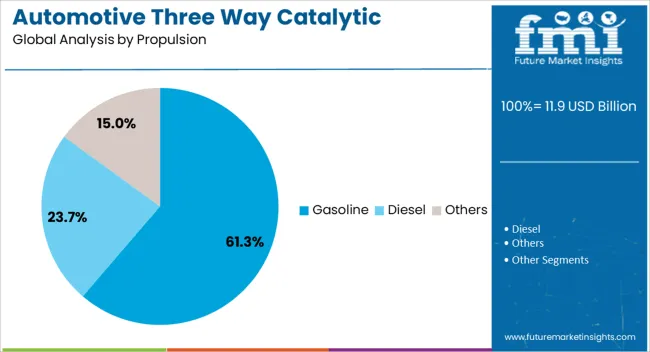
The gasoline propulsion segment dominates the market with a commanding 61.3% share, underscoring its integral role in driving demand for three way catalytic converters. Gasoline engines, which operate with a near-stoichiometric air-fuel mixture, are ideal candidates for this converter type due to their balanced oxygen levels required for efficient pollutant conversion.
Despite the rise of electric vehicles, the global dominance of gasoline-powered cars, especially in cost-sensitive and infrastructure-limited regions, continues to reinforce the segment’s leadership. Innovations in engine downsizing and turbocharging have necessitated more efficient emission control systems, which further boosts demand.
The segment also benefits from lower soot output compared to diesel, simplifying converter design and cost structure. With regulatory agencies maintaining focus on hydrocarbon and carbon monoxide reductions, gasoline vehicles are expected to remain the primary end-use base for three way catalytic converters in the foreseeable future
The automotive three way catalytic converter market is expanding due to rising emission regulations, hybrid vehicle adoption, and growing passenger vehicle production. Opportunities lie in electrification transition, aftermarket replacements, and regional vehicle fleet upgrades. Trends focus on advanced materials, lightweight designs, and improved conversion efficiency. Challenges include precious metal price volatility, regulatory complexities, and competition from electric vehicles. Overall, the market is expected to witness steady growth as manufacturers optimize cost, performance, and compliance while responding to evolving automotive emission standards and consumer demands.
The automotive three way catalytic converter market is witnessing robust demand as stringent emission standards are enforced across North America, Europe, and Asia-Pacific. Increasing production of passenger cars and light commercial vehicles is fueling the requirement for efficient exhaust treatment systems to limit harmful pollutants such as carbon monoxide, nitrogen oxides, and hydrocarbons. Original equipment manufacturers are integrating advanced catalytic converters to meet regulatory compliance and enhance engine performance. Furthermore, the growth of fuel-efficient vehicles, hybrid models, and retrofitting initiatives in older vehicles is expanding the market. Rising consumer awareness regarding air quality and emission control contributes to increased adoption. Regional variations in automotive manufacturing, vehicle lifecycle patterns, and government policies influence demand significantly. Manufacturers are being compelled to balance cost-efficiency with high conversion efficiency and durability, making product innovation and quality a critical focus. The growing automotive production and emission compliance needs collectively drive sustained market expansion.
Opportunities in the automotive three way catalytic converter market are being enhanced by the rise of hybrid vehicles and transitional adoption of internal combustion engines alongside electrified drivetrains. Manufacturers are exploring catalytic solutions tailored for mild hybrids and plug-in hybrids, where exhaust emissions remain a regulatory concern. Governments are offering incentives for low-emission vehicle adoption, indirectly promoting the integration of advanced catalytic converters. The aftermarket segment also provides growth potential, as fleet operators and individual vehicle owners seek replacement or upgraded converters to meet evolving standards. Emerging markets with growing vehicle ownership and rising environmental awareness are presenting new avenues for product deployment. Furthermore, collaborations between OEMs, emission control solution providers, and research institutions allow for development of converters with improved performance, longevity, and cost-effectiveness. Overall, opportunities are being shaped by regulatory pressures, hybrid vehicle adoption, and aftermarket demand, positioning catalytic converters as essential components in cleaner automotive transport systems.
The market trends in automotive three way catalytic converters focus on the adoption of advanced materials, improved designs, and higher conversion efficiency. Manufacturers are increasingly using high-performance ceramics, precious metal coatings such as platinum, palladium, and rhodium, and optimized substrate structures to enhance pollutant removal. Trends also indicate an emphasis on compact, lightweight designs that reduce vehicle weight and improve fuel economy without compromising emission performance. The integration of temperature and oxygen sensors with catalytic systems enables better engine management and optimized exhaust treatment. Additionally, regional emission policies, consumer preferences for fuel-efficient vehicles, and evolving automotive technologies are influencing product specifications and manufacturing strategies. Collaboration between automotive OEMs and material technology providers is fostering innovations that balance cost-effectiveness with regulatory compliance. Digital monitoring of converter efficiency and predictive maintenance solutions are also emerging trends. Collectively, these trends are shaping the market toward higher performance, durability, and alignment with evolving vehicle and regulatory requirements.
Challenges in the automotive three way catalytic converter market are primarily linked to the high cost and volatility of precious metals, complex regulatory landscapes, and growing competition in the automotive components sector. Platinum, palladium, and rhodium prices are subject to market fluctuations, impacting manufacturing costs and profitability. Regulatory standards differ by region, requiring manufacturers to adapt designs, testing, and compliance procedures to meet varying limits on NOx, CO, and HC emissions. Supply chain disruptions and geopolitical issues further exacerbate production risks. Additionally, the growing presence of electric vehicles, which do not require catalytic converters, introduces uncertainty for future demand. Manufacturers must navigate technical challenges to ensure durability, thermal stability, and optimal performance under diverse operating conditions. Strategic sourcing, cost optimization, and design standardization are crucial to address these challenges. Market participants are compelled to balance performance, compliance, and cost pressures while maintaining competitiveness in a changing automotive landscape.
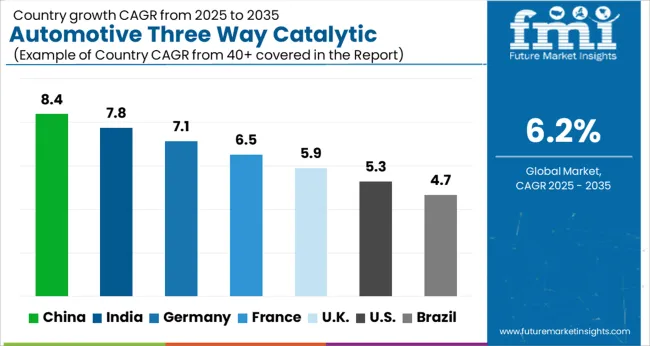
| Country | CAGR |
|---|---|
| China | 8.4% |
| India | 7.8% |
| Germany | 7.1% |
| France | 6.5% |
| UK | 5.9% |
| USA | 5.3% |
| Brazil | 4.7% |
The global automotive three way catalytic converter market is projected to grow at a CAGR of 6.2% from 2025 to 2035. China leads with a growth rate of 8.4%, followed by India at 7.8%, and Germany at 7.1%. The United Kingdom records a growth rate of 5.9%, while the United States shows the slowest growth at 5.3%. Increasing adoption of emission control technologies in vehicles, stringent government regulations on exhaust emissions, and growing consumer preference for environmentally compliant vehicles are driving market expansion. Emerging markets like China and India experience faster growth due to rising vehicle production, urbanization, and supportive policies, while mature markets such as the USA, UK, and Germany focus on upgrading existing fleets with advanced catalytic converter systems. This report includes insights on 40+ countries; the top markets are shown here for reference.
The automotive three way catalytic converter market in China is expanding at a CAGR of 8.4%, primarily driven by rapid vehicle production and adoption of emission control technologies. Government regulations enforcing stricter exhaust emission standards are encouraging manufacturers to integrate advanced catalytic converter systems into new vehicles. Increasing environmental awareness among consumers is further boosting demand for cleaner and fuel-efficient vehicles. Local manufacturers are investing heavily in research and development, focusing on cost-effective and durable solutions. The market in China continues to grow due to strong automotive sales, regulatory compliance, and the rising importance of sustainable mobility solutions.
The automotive three way catalytic converter market in India is growing at a CAGR of 7.8%, supported by rising vehicle production and increasing regulatory focus on emission reduction. Government policies promoting Bharat Stage VI (BS6) norms have accelerated the adoption of advanced catalytic converters in new vehicles. Urbanization, growing disposable income, and environmental awareness are driving consumer demand for low-emission vehicles. Indian manufacturers are upgrading production facilities and adopting innovative technologies to meet compliance requirements. Overall, the market in India benefits from a combination of regulatory enforcement, increasing automotive sales, and rising consumer interest in fuel-efficient and environmentally friendly vehicles.
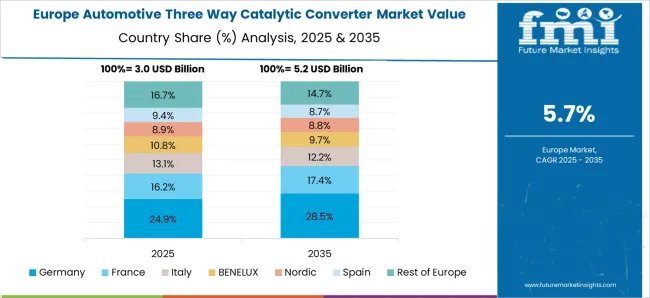
The automotive three way catalytic converter market in Germany is growing at a CAGR of 7.1%, driven by strict European emission standards and strong consumer preference for environmentally compliant vehicles. German automakers are investing in advanced catalytic technologies to enhance vehicle performance while reducing pollutants. Market expansion is also supported by fleet modernization programs and growing adoption of hybrid and fuel-efficient vehicles. Research and development initiatives focus on improving durability, efficiency, and cost-effectiveness of catalytic converters. The German market continues steady growth due to regulatory compliance, technological innovation, and increasing awareness about environmental sustainability in the automotive sector.
The automotive three way catalytic converter market in the United Kingdom is expanding at a CAGR of 5.9%, fueled by the need to meet strict emission standards and growing consumer awareness regarding vehicle pollutants. UK manufacturers and automotive suppliers are investing in advanced catalytic technologies to improve fuel efficiency and reduce harmful emissions. Demand is further supported by fleet upgrades, government incentives for cleaner vehicles, and increased adoption of hybrid and electric powertrains. The market continues steady growth as regulatory compliance, technological advancements, and consumer preference for low-emission vehicles drive adoption.
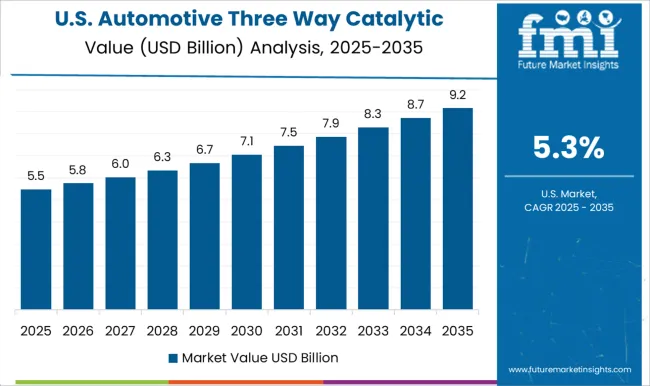
The automotive three way catalytic converter market in the United States is growing at a CAGR of 5.3%, driven by emission regulations, environmental awareness, and demand for fuel-efficient vehicles. US automakers are increasingly integrating advanced catalytic converter systems to comply with federal and state-level emission standards. Growth is further supported by fleet modernization programs, rising consumer preference for low-emission vehicles, and technological advancements in catalytic materials. Overall, the US market experiences steady growth due to regulatory enforcement, adoption of hybrid and fuel-efficient vehicles, and the increasing importance of reducing vehicular pollutants.

The automotive three way catalytic converter market has witnessed significant growth as global emissions regulations tighten and consumer demand for cleaner vehicles rises. Leading players such as Bosal, Corning, and Denso are competing to provide high-efficiency catalytic converters that reduce harmful gases including CO, NOx, and hydrocarbons. Faurecia, Johnson Matthey, and Magna focus on integrating advanced substrate technologies and optimized coating materials to enhance conversion efficiency while minimizing precious metal usage.
Companies like Marelli, Tenneco, and Umicore are leveraging research and development to improve durability, thermal stability, and compatibility with emerging powertrains, including hybrid and compressed natural gas (CNG) engines. Market strategies revolve around expanding regional manufacturing capacities, forming strategic partnerships with automakers, and investing in next-generation emission control technologies. Yutaka and other players emphasize lightweight designs and compact solutions to meet the growing demand for fuel-efficient vehicles, particularly in urban and emerging markets.
Product innovation and stringent compliance with Euro, USA EPA, and China 6 emission standards are central to maintaining a competitive edge. The market landscape is shaped by continuous technological advancements and evolving customer requirements in passenger vehicles, commercial vehicles, and hybrid fleets. Companies such as Bosal and Johnson Matthey are increasingly adopting automated production techniques and advanced coating processes to ensure consistency, reduce costs, and enhance catalytic performance. Regional expansion strategies are evident as manufacturers target high-growth areas in Asia-Pacific, Latin America, and the Middle East to capitalize on rising automotive production and stringent emission norms.
Strategic collaborations with OEMs enable better integration of catalytic converters into vehicle platforms, optimizing exhaust system performance. With the shift toward hybridization and alternative fuel vehicles, catalytic converter designs are being adapted for higher efficiency at lower operating temperatures. Market players that combine innovation, regulatory compliance, and supply chain optimization are expected to maintain leadership and drive sustained growth in the automotive three way catalytic converter market globally.
| Items | Values |
|---|---|
| Quantitative Units | USD 11.9 billion |
| Material | Platinum-based, Palladium-based, and Rhodium-based |
| Vehicle | Passenger vehicles and Commercial vehicles |
| Propulsion | Gasoline, Diesel, and Others |
| Distribution Channel | OEM and Aftermarket |
| Regions Covered | North America, Europe, Asia-Pacific, Latin America, Middle East & Africa |
| Country Covered | United States, Canada, Germany, France, United Kingdom, China, Japan, India, Brazil, South Africa |
| Key Companies Profiled | Bosal, Corning, Denso, Faurecia, Johnson Matthey, Magna, Marelli, Tenneco, Umicore, and Yutaka |
| Additional Attributes | Dollar sales by converter type (ceramic, metallic, dual-layer) and vehicle type (passenger vehicles, commercial vehicles, hybrid/electric) are key metrics. Trends include rising demand for emission-compliant solutions, growth in stringent environmental regulations, and increasing adoption of fuel-efficient and hybrid vehicles. Regional adoption, technological advancements, and regulatory compliance are driving market growth. |
The global automotive three way catalytic converter market is estimated to be valued at USD 11.9 billion in 2025.
The market size for the automotive three way catalytic converter market is projected to reach USD 21.7 billion by 2035.
The automotive three way catalytic converter market is expected to grow at a 6.2% CAGR between 2025 and 2035.
The key product types in automotive three way catalytic converter market are platinum-based, palladium-based and rhodium-based.
In terms of vehicle, commercial vehicles segment to command 50.2% share in the automotive three way catalytic converter market in 2025.






Full Research Suite comprises of:
Market outlook & trends analysis
Interviews & case studies
Strategic recommendations
Vendor profiles & capabilities analysis
5-year forecasts
8 regions and 60+ country-level data splits
Market segment data splits
12 months of continuous data updates
DELIVERED AS:
PDF EXCEL ONLINE
Automotive Carbon Ceramic Brake Market Size and Share Forecast Outlook 2025 to 2035
Automotive Camshaft Market Size and Share Forecast Outlook 2025 to 2035
Automotive Stamping Industry Analysis in India Size and Share Forecast Outlook 2025 to 2035
Automotive Cylinder Liner Market Size and Share Forecast Outlook 2025 to 2035
Automotive Microcontroller Market Size and Share Forecast Outlook 2025 to 2035
Automotive Roof Rails Market Size and Share Forecast Outlook 2025 to 2035
Automotive Active Safety System Market Size and Share Forecast Outlook 2025 to 2035
Automotive Diagnostic Scan Tool Market Size and Share Forecast Outlook 2025 to 2035
Automotive Test Equipment Market Size and Share Forecast Outlook 2025 to 2035
Automotive Dynamic Map Data Market Size and Share Forecast Outlook 2025 to 2035
Automotive Green Tires Market Size and Share Forecast Outlook 2025 to 2035
Automotive E-Tailing Market Size and Share Forecast Outlook 2025 to 2035
Automotive Interior Market Forecast Outlook 2025 to 2035
Automotive Key Market Size and Share Forecast Outlook 2025 to 2035
Automotive Appearance Chemical Market Forecast and Outlook 2025 to 2035
Automotive Seating Market Forecast and Outlook 2025 to 2035
Automotive Domain Control Module Market Forecast and Outlook 2025 to 2035
Automotive Remote Diagnostic Market Forecast and Outlook 2025 to 2035
Automotive-grade Inertial Navigation System Market Size and Share Forecast Outlook 2025 to 2035
Automotive Thin IGBT Module Market Size and Share Forecast Outlook 2025 to 2035

Thank you!
You will receive an email from our Business Development Manager. Please be sure to check your SPAM/JUNK folder too.
Chat With
MaRIA